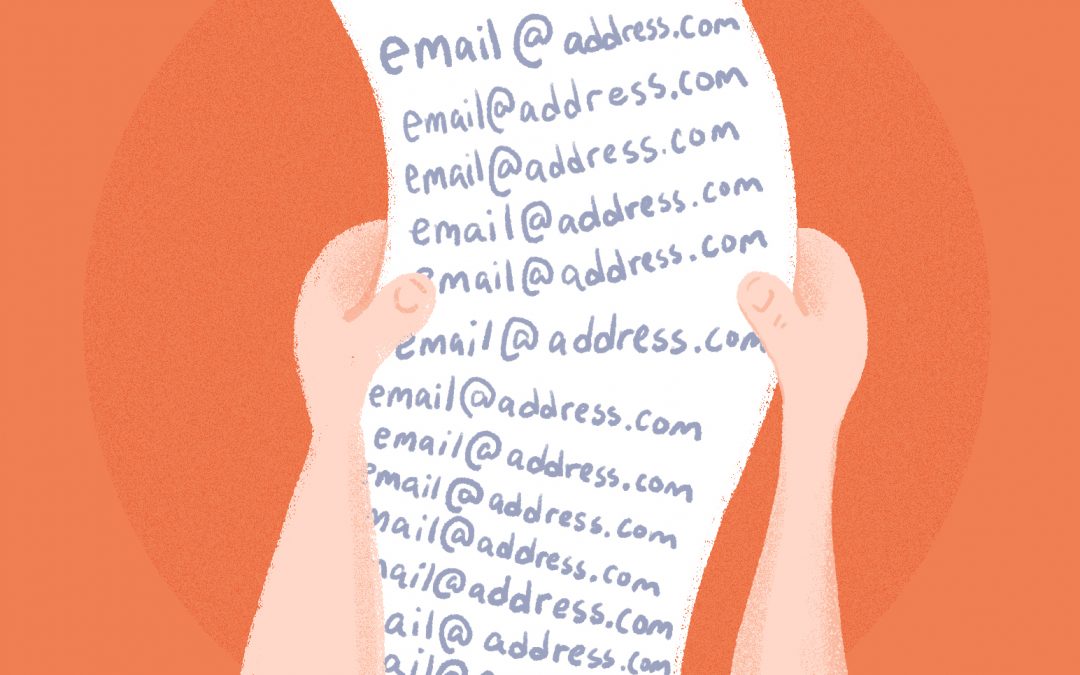Email marketing is one of the most reliable ways to consistently communicate with your audience.
For many organizations and individuals, email lists are automated, revenue-generating machines. They provide a steady stream of traffic and a regular source of content ideas. Email is a direct outlet to the people you’re trying to reach.
But what if you don’t have a thriving email list yet?
Building an email list takes work. It’s not going to happen instantly. Still there are ways to significantly increase your growth, and sharp organizations use them to reach hundreds, thousands, or hundreds of thousands of people.
There are countless prescriptive blog posts explaining how to poof your way into a massive email list. This post isn’t one of them. We’ve pulled together the Internet’s best examples of organizations that experienced massive growth. Some did it overnight. Some took years. We’re going to look at what they did and how they did it, so you can do the same.
Here are 10 case studies on rapidly growing an email list.
1. Buffer: Doubled monthly signups in one month
Industry: marketing software
What they did:
- Increased monthly email signups by 130%.
How they did it:
- Added eight more ways for people to sign up for their list.
Where the study came from: Buffer shared the signup sources they added to grow their email list on their blog in 2014.
For Buffer, the egg came before the chicken. They wrote a lengthy post about ways to grow an email list based on other websites that had large lists, and then they tried those strategies for themselves.
Here’s what their email signups looked like for the two months before they upped their game, and the month they implemented new strategies:
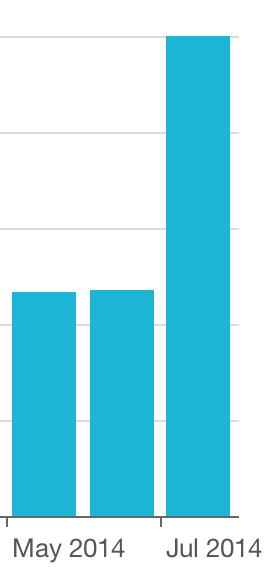
Image source: Buffer
They averaged 2,349 signups in May and June, and then had 5,450 in July.
One of the common themes they saw on sites with big lists was a high number of places for people to sign up. Buffer only had one—so they added eight additional ways for people to sign up for their list.
Not all of these new signup sources got much traction, but take a look at how they each contribute now:
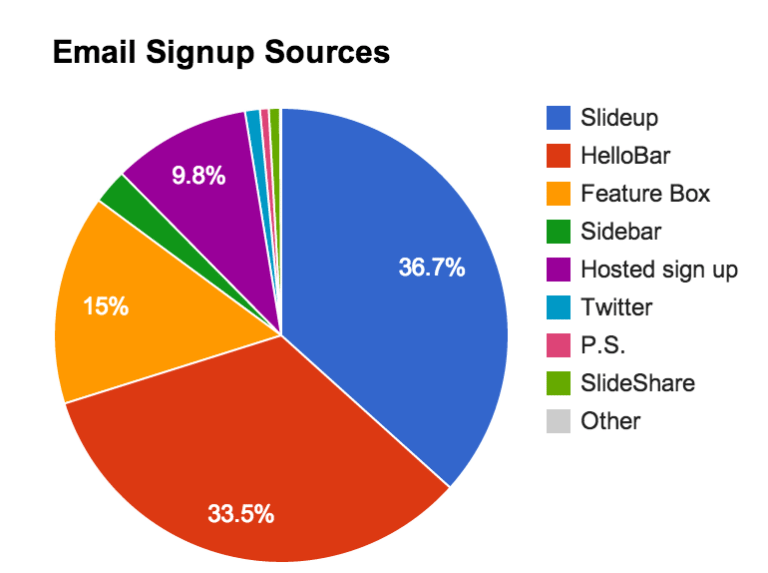
Image source: Buffer
The blue section represents the original signup source (Slideup), which now only accounts for a little over one third of all signups. Of course, some of these new sources siphoned off signups that would’ve otherwise gone to Slideup, but the total signups still increased dramatically.
Buffer explains how they used each individual signup source, but here’s the rough breakdown of how many subscribers each source contributed:
- Slideup: 400+ per month
- HelloBar: 350+ per month
- Twitter lead generation cards: 180+ per month
- Homepage feature box: 150+ per month
- Sidebar: 140+ per month
- SlideShare: 60+ per month
- Postscript: 20-40 per month
- Facebook page email signup: one per month
- QZZR: 345 total
- Other: about 400 per month
Adding more email signup options is all that Buffer claims they changed, and they doubled their monthly signups. Sometimes you have to ask for the signup more than once, and that’s perfectly OK.
It’s worth noting: some email signup sources can be pretty obnoxious for your visitors. While each of these sources are growing Buffer’s list, don’t just start adding signup sources willy-nilly. If a new source isn’t contributing a significant number of signups and it’s taking up prominent real estate on your website, ditch it.
And if your site isn’t already getting significant traffic like Buffer’s, adding signup sources probably won’t move the needle for you.
2. Video Fruit: 0 to 205 email subscribers in 48 hours
Industry: Video editing
What they did:
- Gained 205 subscribers in two days on a brand new email list.
- Generated $247 in revenue in two days.
How they did it:
- Leveraged personal relationships.
- Hosted a giveaway.
Where the study came from: Bryan Harris shared how he built an email list from scratch on the Video Fruit blog in 2015.
Bryan Harris of Video Fruit started with a list of family members and friends who he knew would be interested in the topic he was building an email list around—in this case, the great outdoors. He personally asked each of them if they’d join his list, and wound up with 46 list members in 12 hours.
To keep growing the list, Bryan counted on the fact that everybody knows somebody. But before these people would share his new list with their friends and family, they needed some incentive. So he created a giveaway that was relevant to the list: a canoe and two ENO hammocks. (A local sporting goods store sponsored the giveaway in exchange for being featured in the list, even though it was brand new!) In order to enter the giveaway, people had to share a link to the landing page.
Bryan’s model for email growth is pretty simple. It looks like this:
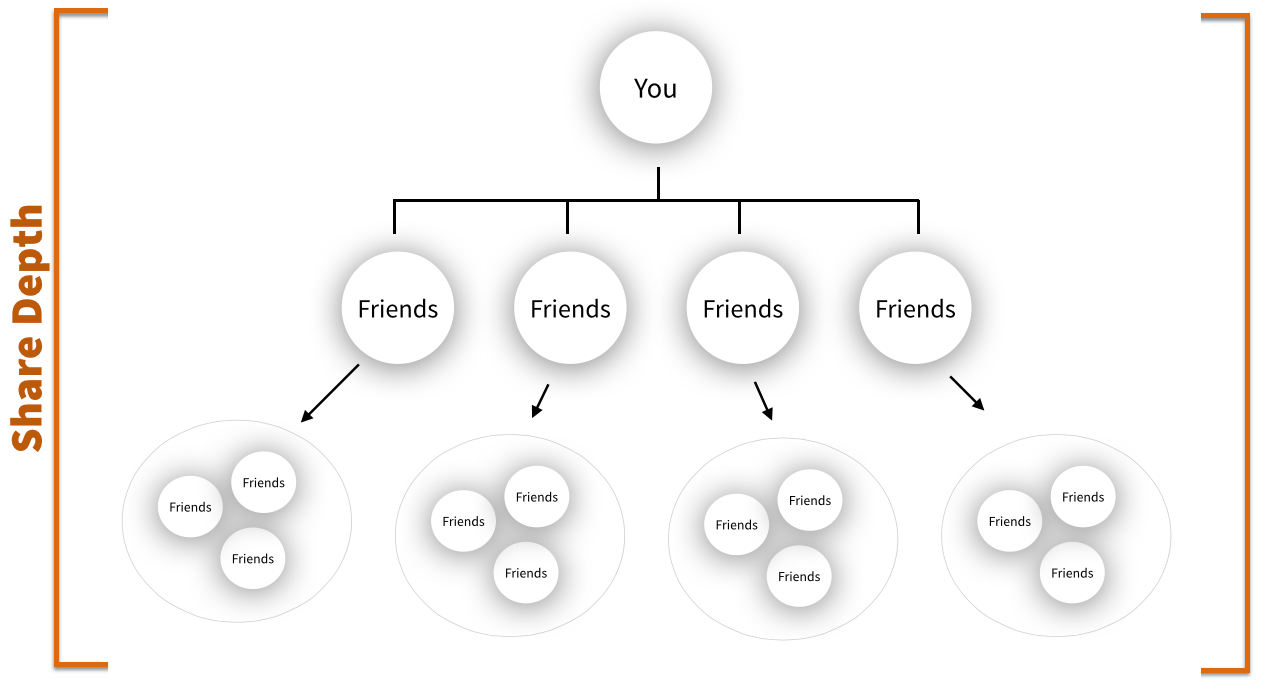
Image source: Video Fruit
The giveaway resulted in an additional 159 subscribers, bringing the list to 205 members in just 24 hours.
Bryan didn’t have a product in mind for this list yet, but he used his early adopters determine what people would pay money for, and then accepted preorders for the yet-to-be-started product.
Bryan’s methods were incredibly informal, but here’s why this case study is valuable to established organizations and startups:
- He had no clients, customers, users, or audience when he started.
- He didn’t even have a product.
- He didn’t spend a dime on a giveaway that was worth $800.
- He used the most active segment of his audience to grow his list and learn what people wanted.
- He didn’t even know what he wanted the list to be about when he started.
If you’re starting from zero, Bryan’s case study provides a helpful model. But probably, you have at least a few advantages over this 48 hour experiment.
Even if you don’t have an email list (or the one you have isn’t doing too hot), your organization probably has existing relationships you can leverage to build an initial list to get started. Or a product you can use in a giveaway to incentivize people to invite their friends. And I bet you already know what you want to email people about.
What I find most interesting about Bryan’s case study is his conversational approach to exploring the list’s potential. He wasn’t afraid to ask people “Hey, if I did this, would you be interested?” before he committed any energy to a task.
It’s nothing flashy, but Bryan’s methods work.
3. AppSumo: 0 to 147K email subscribers in 10 months
Industry: Daily deals roundup
What they did:
- Gained 147,973 subscribers in 10 months.
- Gained 528,238 subscribers in four years.
How they did it:
- Giveaways.
Where the study came from: Noah Kagan (founder of AppSumo) shared how he grew the company’s email list on Andrew Chen’s blog.
AppSumo has been using giveaways for years. Founder Noah Kagan says, “What started out as an experiment for growing our small audience became one of the key marketing activities that helped grow our customer base. . . . The one method I can consistently recommend for people starting their customer base has been giveaways.”
Here’s what their first 10 months of growth through giveaways looked like:
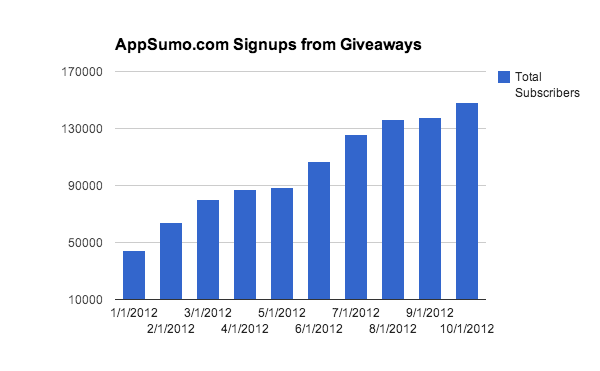
Image source: Andrew Chen
Through experimentation, AppSumo learned what giveaway aficionados know by now: niche giveaways create way better leads than broad giveaways for items everybody wants.
Case in point: AppSumo hosted a MacBook Air giveaway that created over 48,000 new subscribers, but only $11,550.08 in gross profit ($0.24 per new subscriber). Another giveaway offering a one-on-one business getaway with Noah Kagan, however, created just 3,846 new subscribers—but led to $26,572.90 in gross profit ($6.90 per new subscriber).
If you’re trying to build a thriving email list, don’t flood it with a bunch of useless leads. Broad, generic giveaways build broad, generic audiences.
A few other things AppSumo has learned from four years of giveaways:
- Partner with other companies who will promote you and provide giveaway items.
- Buy Facebook ad traffic for the company you’re sponsoring.
- A/B test the messaging on your giveaway.
- Using giveaways to grow your list will increase unsubscribes (some people are just interested in the giveaway—who knew!)
- Giveaways can grow your other audiences as well. Many platforms include options to like or follow your brand for additional entries.
- Frequent giveaways have diminishing returns—do them quarterly at most.
In the four years prior to the case study, AppSumo hosted 25 giveaways and gained 528,238 new subscribers through them.
4. University of Alberta: 500% increase in subscribers
Industry: post-secondary education
What they did:
- Grew their list from 421 subscribers to 2,528 in 10 months.
How they did it:
- Added a chat window signup with Qualaroo.
Where the study came from: On the KISSmetrics blog in 2013, Jason Buzzell of UAlberta shared how his school implemented one of KISSmetrics’ email list building strategies on the campus website.
It’s not enough to give people the ability to sign up for your list. They have to be able to see it.
Before University of Alberta implemented Qualaroo, the only way people could sign up for their daily news list was through a sidebar, which led to this hideous page:
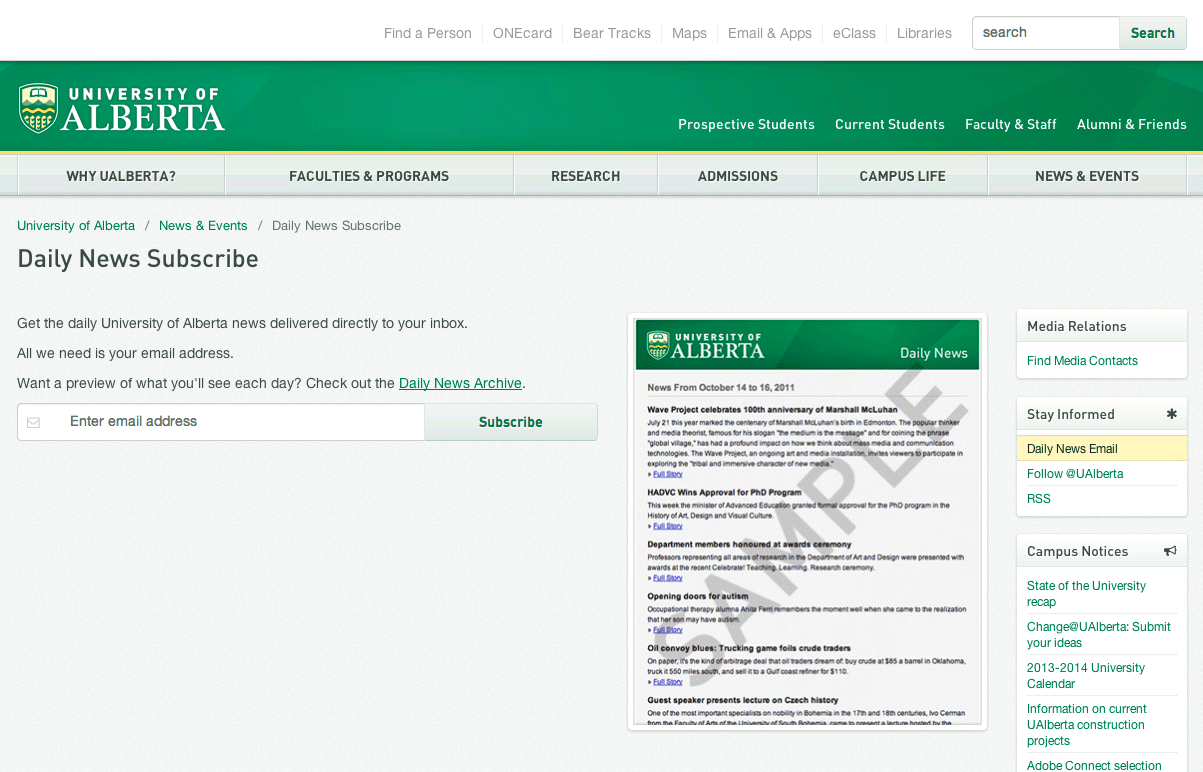
Image source: KISSmetrics
That signup page is still pretty bad, but at least for awhile, they provided engaged readers with another option. When someone read the daily news for 10 seconds, they saw a little chat box like this:
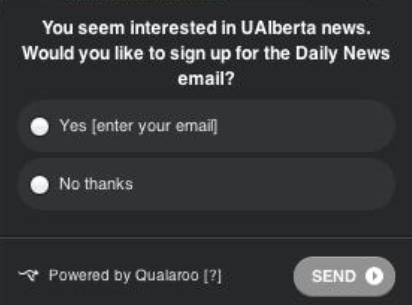
Image source: KISSmetrics
“We generally were seeing one or two sign-ups maximum per day before the nudge was set up,” says Jason Buzzell of UAlberta. “Now, we have days where we see as many as 12 to 15 sign-ups.”
And over nine months, 21.5% of the 12,295 responses were “Yes.”

Image source: KISSmetrics
Here’s how adding Qualaroo affected their total subscribers:
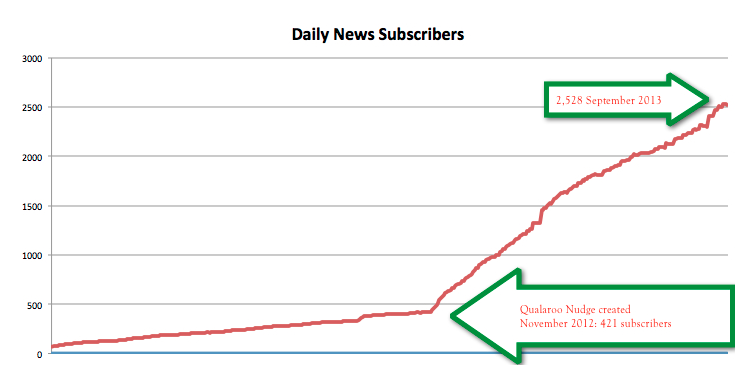
Image source: KISSmetrics
Surprisingly, University of Alberta appears to have ditched Qualaroo, but I’d be willing to bet that says more about them than Qualaroo. It looks like they had a pretty manual process of updating their list, and all it takes is one person leaving (like, say, Jason Buzzell, the guy who wrote this case study) for an administration to start killing good ideas.
If you want people to sign up for your email list, make it visible.
5. Backlinko: 785% increase in signup conversions
Industry: SEO
What they did:
- Increased email signup conversions from 0.54% to 4.82%.
How they did it:
- Content upgrades.
Where the study came from: Brian Dean published this case study on Backlinko in 2014 (it’s been updated since then).
When Brian Dean first published this case study, the idea of content upgrades was pretty new—which is why he got to coin a term which everyone now links to and talks about. Now, it’s standard practice for anyone who takes their email list seriously.
So what’s a content upgrade? It’s a bonus offer that directly relates to the content it appears in. You provide the additional content—such as an ebook, report, or checklist—and people give you their email address.
Brian first experimented with content upgrades on his post, “Google’s 200 Ranking Factors: The Complete List.” After reading or skimming his 200 ranking factors, people were offered a checklist with the top 10 ranking factors. It’s obviously super relevant to the audience, and it adds value to the material they just read—it condenses all that information into an actionable tool.
Before he added the content upgrade, this page was converting 0.54% of visitors into subscribers. Now its conversion rate is 4.82%. That’s an improvement of 785%!
Naturally, savvy A/B testers will ask, “Well, OK, but how big was his sample size?” This is Brian Dean, folks. He doesn’t mess around. He arrived at this 4.82% conversion rate after 4,700 visitors and 370 conversions.
And Brian didn’t just spam his readers with links to this content upgrade, either. He added one link at the top of the post and one at the bottom. (See for yourself.) It doesn’t get in the way of what people actually came to the page for, and it’s related enough that it feels like . . . well, an upgrade.
Brian Dean wasn’t the first to use this technique, but he gave it a name that stuck, and other brands are using it to grow their lists, too.
6. CodeinWP: 450+ new subscribers per month
Industry: WordPress help
What they did:
- Doubled the size of their email list in seven months.
- Increased signup conversions on blog posts by 831% or more.
How they did it:
- Adding signup forms.
- Content upgrades.
Where the study came from: CodeinWP shared their email marketing strategy on their blog in 2015.
CodeinWP blends what we’ve learned so far from Buffer and Backlinko, making their email signup more prominent, and their offers more compelling.
They provide a total of seven different signup options, using these tools:
- ManyContacts
- OptinMonster
- Scroll Triggered Box
- Other “standard embed forms”
A first-time visitor can’t come to their site and consume their content without at least encountering one opportunity to sign up. CodeinWP mentions that as we’ve become bombarded with these signup requests, we essentially become “blind” to some of them. We’ve learned to mentally block out anything that looks like a banner ad.
But CodeinWP’s solution isn’t just to inundate readers with even more buttons. They do, but they also borrow from Brian Dean’s playbook, where they’ve experienced similar results.
CodeinWP’s blog posts that don’t offer content upgrades convert new subscribers at rate of 0.39%. With content upgrades, their conversions range from 1.49% to 6.68%. That’s an increase of 831%–1,613%.
It’s kind of a no-brainer. People like free stuff. And when you already know what kind of free stuff they want (like whatever that blog post was about), bada-bing bada-boom, they give you their email.
7. UAV Coach: 73% increase in subscribers in 7 days
Industry: Drone pilot training
What they did:
- Gained 3,200 subscribers in seven days (457 subscribers per day).
- Over 900 subscribers from Facebook advertising for $0.32 per subscriber.
How they did it:
- One giveaway.
Where the study came from: Copy Tactics used UAV Coach in an email marketing case study they published on the Copy Tactics blog in 2015.
OK, I promise, this is the last case study about using a giveaway. CopyTactics has a pretty elaborate build up to the big reveal about what their client did, but that’s really about all there is to this one: they did a giveaway, and they did it well.
UAV Coach used KingSumo (hey, it’s Noah Kagan again) to give away a . . . you guessed it, UAV. It just so happened to be one UAV Coach received for free, too. The prize was highly relevant to their audience, and while a drone would usually be one of those broad prizes we’d caution against, this is kind of like if Apple gave away an iPad. It still makes sense for them to do that. The only people interested in learning how to fly drones are people who own or want drones.
But what makes this case study uniquely valuable is that UAV Coach already tried a drone-related giveaway. They initially offered a free ticket to a drone convention in Las Vegas. It didn’t include a hotel room or travel costs—which probably costs more than the ticket itself is worth. The results? They had less new subscribers from the entire giveaway than they had in one day of the drone giveaway. CopyTactics says the poor results could also be because “[people] may not like crowds, which come with Las Vegas’ atmosphere.” But let’s be honest: it’s because they didn’t include a hotel room or travel costs, and flying to a conference is a much bigger commitment than having something show up on your doorstep.
Besides the importance of choosing the right prize, here are a few takeaways from this case study:
- Optimize your site for email signups before launching the giveaway.
- Tell your email list about the giveaway before it’s live to create anticipation.
- Find groups and social media communities that would be interested in your giveaway, and share it with them.
- Link to the giveaway from other pages on your site, and promote the heck out of it.
- Advertise your giveaway.
One of the more impressive stats in this study is UAV Coach’s Facebook advertising results. They kept their target audience small and relevant, and they snagged an extra 931 subscriptions for 32 cents a pop.
8. Vero: 150% subscriber increase in four weeks
Industry: Email service provider
What they did:
- Increased blog subscribers by 150% in four weeks.
How they did it:
- Content upgrades.
- Qualaroo surveys.
- Popups for first-time visitors.
Where the study came from: This case study appeared on the Vero blog in 2013.
As an email service provider, you would hope that Vero knows a thing or two about building email lists. With more than 10,000 blog subscribers, it’s safe to say they do.
This case study is several years old, but it’s still a good model of some basic techniques you can use on your blog to increase subscribers. For the most part, Vero’s results come down to two things you’ve heard before:
- Increase the visibility of your signup forms.
- Increase the relevance of signing up for your newsletter.
In the four weeks the case study focuses on, Vero added a few elements to their blog:
- Unique calls to action on every post.
- Header for new visitors, directing them to sign up.
- Sidebar promoting popular posts and their newsletter.
- Qualaroo survey that led to a signup option.
- Dedicated landing page promoting the newsletter.
Together, this led to a 150% increase in subscribers over four weeks, but Vero also breaks down the specific impact of a couple key changes.
Qualaroo alone increased Vero’s blog conversions by 25%. The popup survey asked readers how often they read Vero’s posts, and then prompted people who responded “Once every now and then” to subscribe.
Adding a sidebar accounted for a 30% increase in subscribers. This drove people to the dedicated landing page, where it was easy for people to sign up and understand the benefit of subscribing.
Vero didn’t approach “content upgrades” the same way other organizations on this list have. Instead of creating a new guide, report, or checklist based on the post, they simply reframed the their existing offers with a unique call to action.
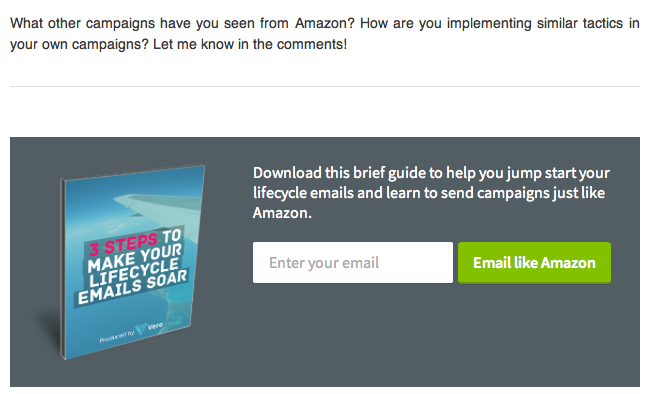
Image source: Vero
A lot has changed since 2013. Like many organizations, Vero has abandoned the header signup form. And Qualaroo. And the dedicated landing page. And they’ve even reverted to generic CTAs. You’ll find this at the end of pretty much every post:
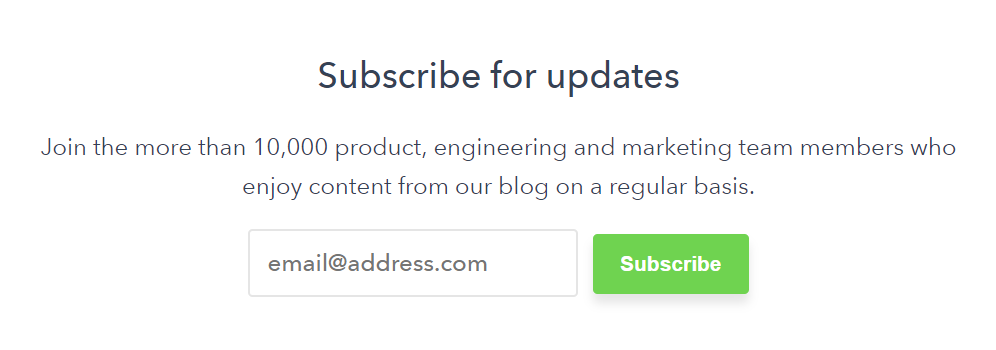
Image source: Vero
But perhaps most importantly, at the time we wrote this case study roundup, Vero’s most recent blog post was from a year ago.
It’s possible that this is another example of the collateral of employee turnover. Jimmy Daly was the head of content marketing at Vero for almost two years, and during that time he got Vero’s website a lot of attention—he got 1,000 email subscribers from a single blog post. But he left in 2016, around the time the blog became inactive.
What I’m trying to say is: do as they say, not as they do.
9. Baked NYC: 68% increase in leads through advertising
Industry: Baked goods
What they did:
- 68% increase in leads.
- 30% reduction in cost per lead.
How they did it:
- Facebook advertising.
Where the study came from: Baked NYC was featured by Facebook as an example of how Facebook advertising can help acquire affordable leads.
Baked NYC wanted to broaden their local customer base, grow their email list, and get some preorders for their Thanksgiving pies.
Being in New York City, they obviously have a pretty big advantage over most localized businesses when it comes to the potential audience size. But it’s also hard to stand out. Facebook advertising allowed them to cut through the noise and pay to reach new customers.
Baked NYC produced some surprisingly professional ads with a pretty tight budget. They spent $35 on equipment, then used a phone and some apps to create stop motion videos with animated text.
They used these videos to create “Facebook lead ads.” The pre-populated forms let people quickly sign up for your email list without leaving their newsfeed.
These ads were highly targeted, isolating Facebook users who lived within a one mile radius of one of Baked NYC’s locations. The campaign resulted in a 68% increase in leads, and those leads cost them 30% less than leads from other sources.
10. Hubble Contacts: 3,000 leads through advertising
Industry: disposable contact lenses
What they did:
- Gained 3,000 leads for $2.30 per lead.
How they did it:
- Facebook lead generation ads.
Where the study came from: Hubble Contacts was featured by Facebook as an example of how Facebook advertising can help acquire affordable leads.
Before Hubble Contacts even launched their product, they used Facebook advertising to acquire 3,000 email addresses from people who wanted to hear about it.
This earlier interest in the product played a big role in helping them secure the seed money they needed to ramp up their efforts.
“This initial Facebook lead generation campaign was a big deal for our business,” says Co-CEO Jesse Horwitz. “We hadn’t launched yet, and had already raised a $3.5 million seed. The data from this campaign was key to raising a $3.7 million seed bridge before launch, which gave us the capital to lean heavily into marketing from day one.”
It isn’t clear who Hubble Contacts targeted for these ads, but it looks like it wasn’t isolated to the U.S.
“Our success on Facebook pushed us to think about international expansion far earlier than we would have otherwise,” says Dan Rosen, head of creative at Hubble Contacts. “Facebook is a great platform in that it makes such expansion very easy from a marketing perspective. I would urge companies not to underestimate Facebook’s depth; if you think a little bit harder, you can probably find more efficient spend opportunities on the platform.”
Even without an established product or content, Facebook advertising can help you build an affordable list of the right people.
Honorable mention: Quality Stocks’ one change on one page
Industry: Stock market advice
What they did:
- 99% increase in subscriber growth over six months.
How they did it:
- Added a lightbox popover.
Where the study came from: Aweber published this case study on their site.
We’ve seen this several times already, but this is another example of how even small changes to the visibility of your email sign up can lead to big increases in growth.
AWeber says that Quality Stocks made one change on one page: they added a lightbox popover to their about page. And it’s not even pretty:

Image source: AWeber
In an ideal world, you’d have a beautiful, branded website. But in a pinch, something’s better than nothing. (Keep in mind though, popovers on mobile can hurt your SEO rankings, which means less traffic.) If you don’t have some obvious way for people to sign up for your list, you’re letting subscribers slip into the abyss of the Internet where you may never see them again, even if you follow them with retargeted ads.
The best ways to grow your email list
By now you’ve seen a few things come up repeatedly—visibility, relevant CTAs, giveaways, and advertising. If people can’t see your email list, they’re not going to sign up. Plain and simple. The trick is to find the best ways to make your email list visible without being obnoxious.
Make it easy to sign up for your list
It helps to think about what kind of experience you like to have when you visit a website, but don’t let that be your only guide (it’s a wee bit subjective). As you add new ways for people to encounter your list, pay attention to your bounce and exit rates and the time people spend on your pages. Consider running A/B tests to isolate the effects of your changes—then you can make decisions backed by data.
What makes Buffer’s case study so valuable is that they measured the impact of each additional email capture, so you can get an idea of which ones are most worth pursuing.
Give people a good reason to sign up
At Overthink Group, we generally advocate for quality over quantity. Well placed, relevant asks create happier website visitors and more effective email captures. As you saw with Brian Dean’s case study (and the derivative ones), content upgrades give people a really compelling reason to join your list and stay there.
Giveaways can give you a boost—but don’t rely on them
Giveaways take a lot of work to pull off well. AppSumo runs huge giveaways fairly often, but keep in mind: they make a giveaway hosting platform. Of course they love giveaways. And AppSumo’s target audience is basically people who love deals, so there’s that, too.
If you’re going to run a giveaway, make sure the prize is as relevant as possible to the people you want on your list. And as we saw in UAV Coach’s case, choose a prize that doesn’t require people to spend additional money.
Giveaways can be a good way to inject a new group of people into your email list, but keep in mind: they only joined your list for a chance to get something for free. There’s always going to be a spike in unsubscribes when your giveaway ends. Noah Kagan says to focus on the overall growth of your list, but pay attention to the value you’re getting from your list afterwards, too. If all of a sudden nobody’s opening or clicking through your emails, or none of your giveaway subscribers go on to make a purchase or interact with you again, it might be time to look at other ways to get more subscribers.
You can probably find more compelling reasons for someone to join your email list. A giveaway might give you a quick win, but we can help you create a more effective long term growth strategy.
Take advantage of Facebook advertising
Obviously, advertising costs money. But targeted ads let you focus that money on the most relevant audience, so you can acquire qualified leads. Facebook gave some good examples, but you should also check out how we got more than 12,000 quality leads for 24 cents a pop.
Make growth a priority
The bottom line is that if you want to grow your email list, it’s going to take work. At Overthink Group, we work with your team to find the right strategies for your organization. We can even execute on them for you. Either way, we do what’s best for our clients and the people they serve long term—not just the length of a contract. It’s our way of leaving the world better than we found it.
Let’s talk about your email list.

